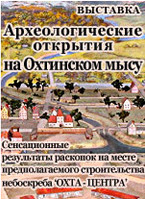
Museums: “Archaeological discoveries on the Okhta Cape” kicks off in Moscow
On January 12 2011 the Andrei Sakharov Museum and Public Center in Moscow opened an exhibition “Archaeological discoveries on the Okhta Cape”. This is an exhibition of archaeological finds, discovered on the Okhta cape, right where “Gazprom Neft” was planning to erect its “Okhta Center” skyscraper in St. Petersburg.
The exhibition showcases the history and archaeology of the Okhta Cape. As a result of many years excavations undertaken by the St. Petersburg Archaeological Expedition of the North-Western Research Institute of Cultural and Natural Heritage and the Institute for the History of Material Culture of Russian Academy of Russian Academy of Sciences on the Okhta cape, here were discovered and examined the sites of ancient people of 4th-2nd centuries B.C., fortifications of a 13th c. medieval settlement and Swedish fortresses of Landskrona (13th c.) and Nyenschantz (17th c.), as well as a late medieval cemetery of the Russian settlement Nevskoye ustye (15th – 16th cc.).
Archaeologists believe that finds of the Okhta Cape, which cast the light on the life of people on the site of modern St. Petersburg starting from 4th c. B.C., may become the basis for a unique museum exposition on St. Petersburg’s archaeology.

